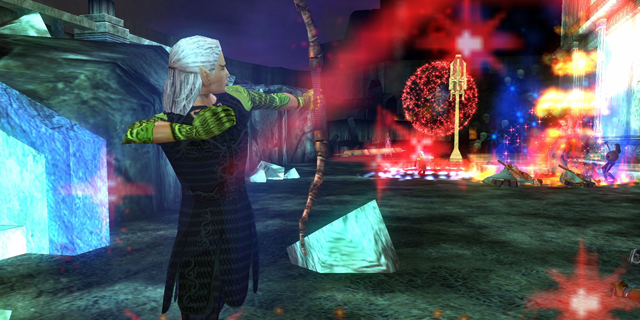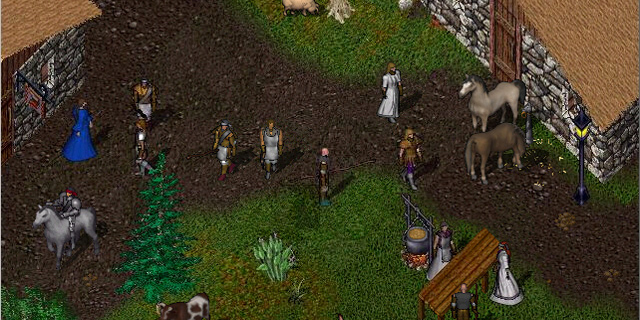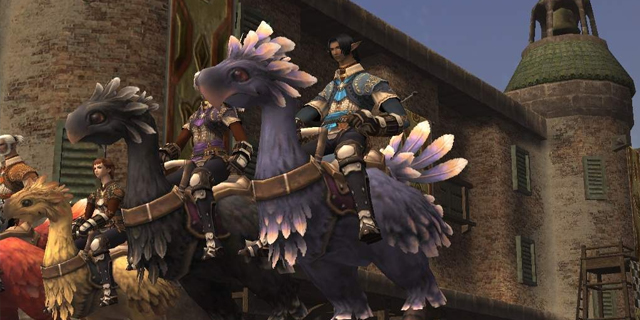
The massively-multiplayer genre has always been polarizing among PC gamers. While some are staunch supporters of their chosen game, others can’t stand them at all, thinking them no more than a meaningless timesink. And others love them not as a game, but as a social experience. Something of a social network built within a game, as opposed to a game like Farmville, built within a social network.
MMOs are incredibly derivative, typically built upon the previous games, with changes and additions. A completely original experience is generally rare, though often quite successful, especially when a game decides to tailor itself to a certain type of player. Here’s a look at the history of the genre, and look at how it has evolved over time.
The genre really began with Multi User Dungeons (MUDs). Text-driven, these games tried to take the descriptive gameplay of Dungeons and Dragons, and move it online, with varying degrees of success. In fact, some of them are still around today. There were a few attempts at graphical “RPG”-style games, however it wasn’t until Origin expanded its Ultima series onto the Internet with Ultima Online that they hit success. Ultima Online‘s release was, simply put, a disaster by today’s standards. The game was horrendously laggy, filled with bugs and debuted featuring game mechanics that allowed for rampant griefing of other players.

As the first foray into the genre on a large scale, the game simply did not take into account the attitudes and behaviors of players online. The player-killing and griefing was not intended to be common; the intent was to allow players to role-play their chosen character with as much freedom as possible, much like the single-player games. Eventually, when alternatives appeared on the market, the player-killing was shown to be bad for Origin’s bottom line when players began to decrease and stop playing as a result. The game was then changed to allow players to play free of danger in a separate “safe” copy of the world, and could venture into the open player-versus-player (PvP) area whenever they wished. Ultima Online is still in operation today, managed by EA BioWare.
After Ultima, the 3D revolution overtook PC gaming, and we all had to make that switch to dedicated graphics hardware. Along with this came EverQuest. EverQuest and its expansions took the MMO into the world of polygons, and gave us the perspective and interface we see in more modern games. This was also the first MMO to really get a lot of attention, as the Internet was commonplace by this point. The other thing this game brought? Expansions. Tons of them. And they were $30-40 each, releasing every six months or so at its peak. The paid content/DLC controversy is by no means a new thing for the game industry.
After EverQuest, the game industry took note, seeing the MMO as a potential cash cow. With the potential for profit from game sales, expansion packs and the ever-lucrative monthly fee, it was clear that this was a pie everyone wanted a piece of. The industry went through a real slew of MMOs here, some successful, most not. The successful ones took an aspect of the genre and used it to set itself apart from the rest. Dark Age of Camelot, for example, provided what is still regarded as one of the best large-scale PvP experiences with its Realm vs. Realm system, where the playerbase was split into three factions.

Of course, the ubiquitous Final Fantasy, after the massive success of Final Fantasy X, decided to enter into the online RPG arena too. Final Fantasy XI was unique as it was the first attempt at playing an online RPG with a console on the PlayStation 2. It was also the first Final Fantasy to be developed for PC at the same time as the console version. Although it was a success, the high entry price for PS2 owners (they had to buy the hard drive with the game) and an unwieldy user interface designed for controller navigation meant that the game would generally only be embraced by fans of the Final Fantasy series, and the MMO audience already on PC would move on to other games. Its fanbase was very loyal, however, and the game is still running today. (Square Enix’s second Final Fantasy MMO, Final Fantasy XIV, has not fared as well, with Final Fantasy XIV‘s development team essentially changing soon after release. The game was free to play for almost a year, and a massive update and re-release of the game is due out at the end of 2012.)
Movies were not left out, as the long awaited Star Wars Galaxies appeared as EverQuest was fading. Plagued with bugs, this game defined how badly an MMO launch can go, but recovered and became fairly successful. While known for being patched into ruin by its own development team, struggling to keep the game alive, its first years are still regarded fondly by former players. It closed its doors at the end of 2011, just days before another Star Wars MMO was to begin.
What followed these, of course, was World of Warcraft.
Look for part two of this feature next week.



















